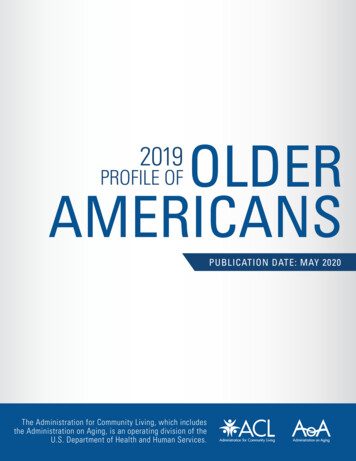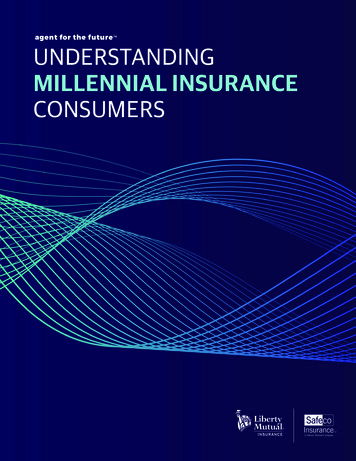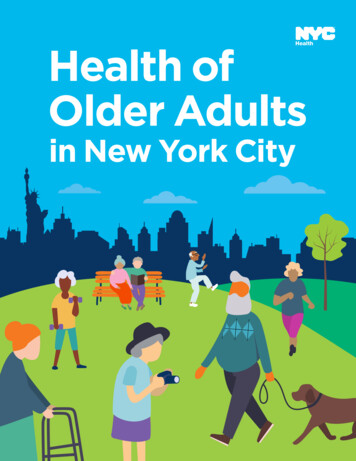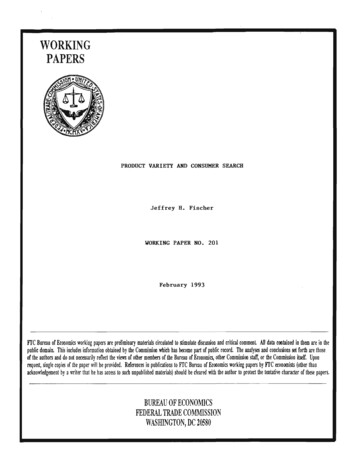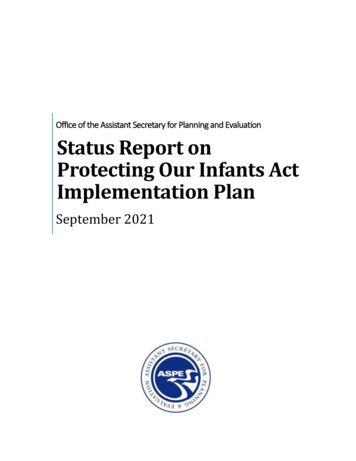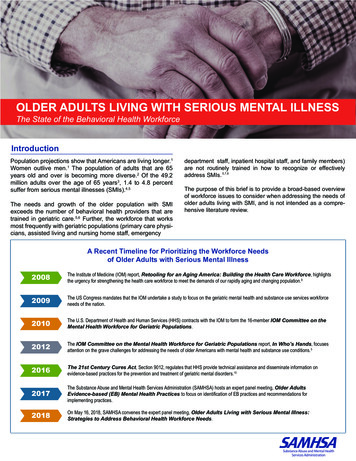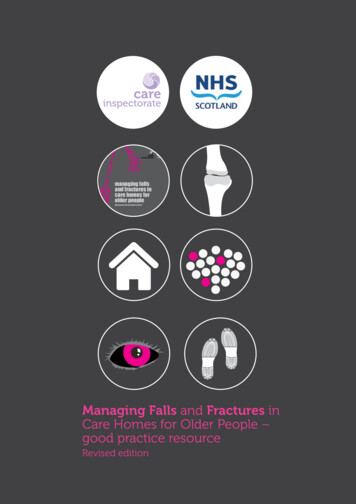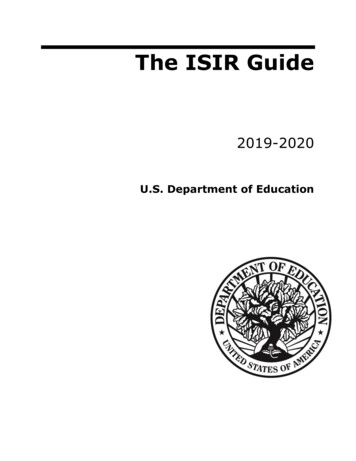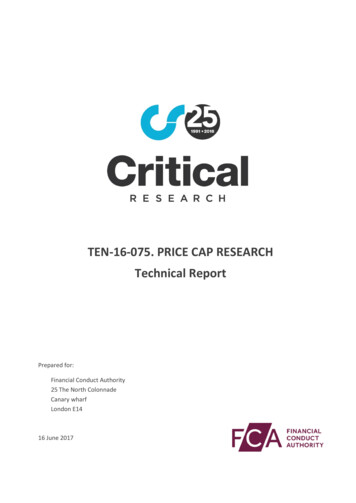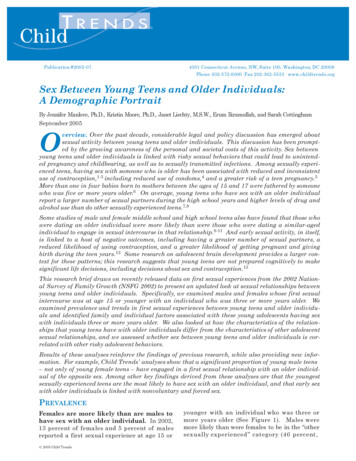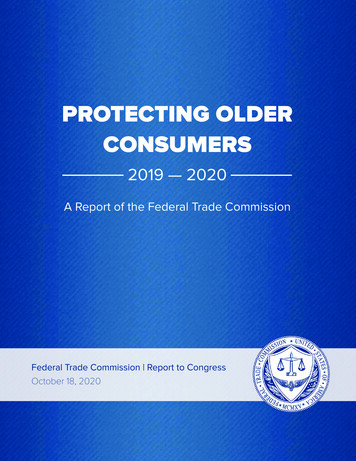
Transcription
PROTECTING OLDERCONSUMERS2019 — 2020A Report of the Federal Trade CommissionFederal Trade Commission Report to CongressOctober 18, 2020
PROTECTING OLDERCONSUMERS2019 — 2020A Report of the Federal Trade Commission to CongressOctober 18, 2020FEDERAL TRADE COMMISSIONJoseph J. Simons, ChairmanNoah Joshua Phillips, CommissionerRohit Chopra, CommissionerRebecca Kelly Slaughter, CommissionerChristine S. Wilson, Commissioner
ContentsI.Introduction . 1II.Developing Effective Strategies to Protect Older Consumers . 2A. Research and Data Analysis. 21. Consumer Sentinel Reports from Older Adults . 32. Alerting the Public to Consumer Reporting Trends . 133. Hearing Directly from Older Consumers About FTC Imposters. 14B. Coordinated Efforts to Protect Older Consumers . 15III.FTC Enforcement Activities Affecting Older Consumers. 16A. Credit Card Interest Rate Reduction Scheme . 17B. Deceptive Publications and Government Check Program . 17C. Business Opportunities, Pyramids, and Money-Making Schemes . 18D. Assisting and Facilitating Payments . 21E. Unsubstantiated Health Claims . 22F. Other Enforcement Highlights . 291. Warning Letters . 292. Case Resolutions . 323. Consumer Monetary Relief . 344. Criminal Liaison Unit . 35IV.Outreach and Education Activities . 36A. Pass It On Education Campaign . 36B. Communicating through Video. 37C. Common Ground Events. 38D. Other Outreach Relating to Older Adults . 38E. Coronavirus Education and Outreach to Older Adults . 39V.Conclusion . 41Appendix A . 42
Protecting Older Consumers October 2020I. IntroductionAs the nation’s primary consumer protection agency, the Federal Trade Commission(“FTC” or “Commission”) has a broad mandate to protect consumers from unfair or deceptiveacts or practices in the marketplace. 1 It does this by, among other things, filing law enforcementactions to stop unlawful practices and, when possible, returning money to consumers. The FTCalso protects the public through education and outreach on consumer protection issues. Throughresearch and collaboration with federal, state, international, and private sector partners, the FTCstrategically targets its efforts to achieve the maximum benefits for consumers, including olderadults. 2Protecting older consumers in the marketplace is one of the FTC’s top priorities. 3Unfortunately, in numerous FTC cases, older adults have been targeted or disproportionatelyaffected. For example, as discussed below, the FTC has brought ten new enforcement actionsthis year to stop unsubstantiated claims for products that purport to treat various illnesses andconditions affecting older consumers. As the population of older adults grows, the FTC’saggressive efforts to bring law enforcement actions against scams that affect them, as well asprovide useful consumer advice, become increasingly important. 4The FTC submits this third annual report to the Committees on the Judiciary of theUnited States Senate and the United States House of Representatives to fulfill the reportingrequirements of Section 101(c)(2) of the Elder Abuse Prevention and Prosecution Act of 2017. 5The law requires the FTC Chairman to file a report listing the FTC’s enforcement actions “overthe preceding fiscal year in each case in which not less than one victim was an elder or thatinvolved a financial scheme or scam that was either targeted directly toward or largely affectedelders.” Given the large number of consumers affected in FTC actions, this list, found in1The FTC has wide-ranging law enforcement responsibilities under the Federal Trade Commission Act, 15 U.S.C.§ 41 et seq. and enforces a variety of other laws ranging from the Telemarketing and Consumer Fraud and AbusePrevention Act to the Fair Credit Reporting Act. In total, the Commission has enforcement or administrativeresponsibilities under more than 70 laws. See http://www.ftc.gov/ogc/stats.shtm.2This report focuses on the Bureau of Consumer Protection’s work to protect older adults. The FTC’s Bureau ofCompetition also serves older adults through its work in various sectors of the economy, such as health care,consumer products and services, technology, manufacturing, and energy.3This report refers to persons 60 and older when using the terms “older adults” or “older consumers” to beconsistent with the requirements in Section 2(1) of the Elder Abuse Prevention and Prosecution Act, whichreferences Section 2011 of the Social Security Act (42 U.S.C. 1397j(5)) (defining “elder” as an individual age 60 orolder).4According to U.S. Census Bureau projections, by 2030 all baby boomers will be older than 65 and “one in everyfive Americans is projected to be [at] retirement age.” See Jonathan Vespa, Lauren Medina, and David M.Armstrong, U.S. Dep’t of Commerce, U.S. Census Bureau, Demographic Turning Points for the United States:Population Projections for 2020 to 2060, (Mar. 2018, Rev. Feb. 2020), at 1, available y/publications/2020/demo/p25-1144.pdf.5Public Law 115–70, 115th C. 9-45ongress (enacted Oct. 18, 2017).FEDERAL TRADE COMMISSIONFTC.GOV1
Protecting Older Consumers October 2020Appendix A, includes every administrative and federal district court action filed in the one-yearperiod. In addition, the FTC files this report to provide detail on the agency’s efforts to protectolder consumers, including its research and strategic initiatives, its law enforcement actions thatimpacted older adults, and its targeted consumer education and outreach.II. Developing Effective Strategies to Protect Older ConsumersThe FTC conducts research and analysis, publishes information about patterns and trends,and engages in coordinated efforts to protect older adults from financial loss and assist them withother consumer issues such as identity theft protection. The agency also works closely withstakeholders to learn about the top issues concerning older adults. The FTC can then use itslimited resources strategically to respond to the needs of older consumers through enforcement,policy, education, and other initiatives.A. Research and Data AnalysisThe FTC’s most recent fraud survey released in October 2019 found that 15.9 percent ofsurvey participants—representing 40 million U.S. adults—were victims of one or more of thefrauds included in the survey. 6 That same research demonstrated that, contrary to popularthinking, older Americans are not necessarily defrauded at higher rates than younger consumersfor the surveyed frauds. 7 Nevertheless, certain types of scams are more likely to affect certaingroups. For example, older adults in the survey (ranging in age from 55 to 74) were more likelyto be victims of fraudulent computer repair (“tech support”) schemes than were youngerconsumers. 8The FTC collects and analyzes consumer report information through its ConsumerSentinel Network (“Sentinel”) to inform its consumer protection mission. Sentinel is an onlinedatabase that provides federal, state, and local law enforcement agencies with secure access toreports from consumers about the fraud and other consumer problems they have experienced.Law enforcement agencies and other organizations 9 contribute consumer reports to the database,which is searchable by criteria such as the type of fraud and the name, address, and telephonenumber of the reported entity. Using Sentinel, the FTC and its law enforcement partners cananalyze reports filed by older adults to look for patterns and trends, identify problematic businesspractices and enforcement targets, and develop cases against targets under investigation.6FTC Bureau of Economics Staff Report, Mass-Market Consumer Fraud in the United States: A 2017 Update, at23-24 (Oct. 2019), available at te/p105502massmarketconsumerfraud2017report.pdf (hereinafter “FTC Fraud Survey”).7Id at 76.8Id at 76-77, 79.9A list of Sentinel data contributors, including the U.S. Senate Special Committee on Aging and the AARP FraudWatch Network, is located at network/data-contributors.FEDERAL TRADE COMMISSIONFTC.GOV2
Protecting Older Consumers October 20201. Consumer Sen nel Reports from Older AdultsDuring calendar year 2019, Sentinel took in more than 3.2 million reports fromconsumers directly and through its data contributors. Of that number, 1.7 million reports wereabout fraud, 650,547 were about identity theft, and another 907,521 were about other consumerproblems. 10 Consumers reported losing over 1.8 billion to fraud in 2019. About half of fraudreports filed in 2019 included consumer age information. Consumers who said they were 60 andolder (older adults) filed 318,850 fraud reports with reported losses of more than 440 million.Key findings from the 2019 Sentinel data are: Older adults (ages 60 and over) were still the least likely of any age group to reportlosing money to fraud.Older consumers continued to report higher individual median dollar losses thanyounger adults (ages 20-59). The disparity in reported losses was particularly largeamong people 80 and over compared to younger adults.Older adults continued to be much more likely than younger consumers to reportlosing money on tech support scams, prize, sweepstakes and lottery scams, andfamily and friend impersonation.Online shopping was the most commonly reported category of fraud in which peopleof all ages indicated they lost money, but older adults were less likely to report losingmoney to online shopping fraud than younger adults.Romance scams, government imposter scams, and prize, sweepstakes and lotteryscams caused the highest aggregate reported losses for older adults.When comparing contact methods, phone scams continued to result in the highestaggregate reported losses by older adults, particularly those 80 and older.Gift cards were still the overall payment method of choice for scammers, but wiretransfer payments reportedly took the most dollars from older adults.These findings, explored more fully below, help inform the FTC’s consumer education and lawenforcement mission.10See generally FTC, FTC Consumer Sentinel Network (July 8, 2020), available .commission. These figures do not include reports about unwantedcalls. Consumer Sentinel data is self-reported and not a survey. As such, individuals decide whether to file a reportand decide what information, if any, to provide. As noted below, not all consumers who file a report provide theirage, payment method, amount of dollar loss, etc.FEDERAL TRADE COMMISSIONFTC.GOV3
Protecting Older Consumers October 2020a) Most Older Consumers Who Filed Fraud Reports Avoided Losing Any MoneyAs in 2017 and 2018, the overwhelming majority of Sentinel fraud reports filed in 2019by consumers 60 or older did not indicate any monetary loss. Figure 1, which controls forpopulation size, 11 shows that older adults were 64% more likely to file these no-loss reportsabout fraud they had spotted or encountered – but avoided losing money on – than consumersages 20-59.Moreover, it remained true in 2019 that older adults were less likely than youngerconsumers to report losing any money to fraud. Figure 1 shows that, after controlling forpopulation size, older adults were 21% less likely to report losing money to fraud thanconsumers ages 20-59. This suggests that older adults may be more likely to avoid losing moneywhen exposed to fraud, more inclined to report fraud when no loss has occurred, or acombination of these or other factors. As mentioned, the FTC fraud survey also found that therates of victimization for the various categories of frauds included in the survey were generallylower for those 65 and older than for younger consumers. 1211The comparison of older adults and younger consumers is normalized against the population size of each agegroup. The analysis is based on U.S. Census Bureau data for population by age. See U.S. Census Bureau, AnnualEstimates of the Resident Population for Selected Age Groups by Sex for the United States (June 2020), available emo/popest/2010s-national-detail.html.12See FTC Fraud Survey at 76-79.FEDERAL TRADE COMMISSIONFTC.GOV4
Protecting Older Consumers October 2020b) Older Adults Reported Higher Median Individual Dollar Losses than Younger ConsumersIn 2019, the broad trend from prior years held: younger consumers were more likely toreport losing money to fraud than older consumers, but older consumers who did report losingmoney reported much higher individual losses. Consumers 80 and over reported the largestmedian losses of 1,600. The median individual dollar loss for this 80 and over age group wasabout two to four times the median loss amounts reported by other age groups. These overallfindings were about the same as those reported in 2018, with the median loss for those 80 andover decreasing slightly from 1,700 in 2018 to 1,600 in 2019. 13A closer look at the data shows a trend toward significatly lower median losses for olderadults than appears at first glance. Higher reported median individual dollar losses in 2018 ascompared to 2017 were due in large part to a surge in reports by older adults of losses toscammers posing as the Social Security Administration (SSA). 14 Reports by older adults of SSAimposters continued to climb through the first quarter of 2019, when the median dollar lossreported by older adults reached 801, the highest on record. 15 However, the numbers declinedin subsequent quarters, a trend that has continued in 2020. By the second quarter of 2020, themedian individual dollar loss reported by older adults fell to 419, about half the high reached13See FTC Report to Congress, Protecting Older Consumers 2018-2019, at 4-5 (Oct. 18, 2019), available eral-tradecommission/p144401 protecting older consumers 2019 1.pdf.14Id.15The median individual dollar loss reported in Q1 of 2019 by age group was 700 (60-69), 900 (70-79), and 2,000 (80 and over).FEDERAL TRADE COMMISSIONFTC.GOV5
Protecting Older Consumers October 2020just over a year earlier. 16 The marked decline in median losses during this period can beexplained, in part, by changes in the types of frauds in which older adults most often reportedlosing money and a decline in reports of phone fraud, as discussed below.Additional insights can be found by looking at the Sentinel reports filed on behalf ofolder consumers by adult children, spouses, caretakers, or others. In 2019, about 18% of reportsfor people 80 and over indicated they were submitted by a person on behalf of the consumer,compared to about 5% for people 70-79 and less than 3% for all other age groups. 17 Notably,reported losses were higher for all reports submitted by third parties, but the median dollar lossfor reports filed on behalf of adults 80 and over, at 3,800, was much higher than other reports. 18Also of note, nearly 90% of reports filed on behalf of people 80 and over were about a scam thatstarted with a phone call. This suggests that third party interventions can be very helpful forrecognizing and reporting fraud, especially where higher individual dollar losses occur.c) Some Types of Fraud Affected Older Consumers Differently from Younger ConsumersTo identify the top scams that had a financial effect on consumers, Figure 3 displays thetop fraud categories reported by older consumers in which they indicated they lost any money.The dark teal bars show the number of loss reports submitted by older adults (age 60 and over),and the light green lines show the number of loss reports filed by younger people (ages 20 to 59)for each category of fraud. As shown in Figure 3, controlling for population size, older adultswere more likely than younger consumers to report financial losses to certain types of frauds, butless likely to file loss reports on many other frauds. Three categories of fraud stand out. Olderadults were: 1) nearly six times, or 474%, more likely than younger consumers to report losingmoney on a tech support scam; 2) three times more likely to report a loss on prize, sweepstakesor lottery scam; and 3) more than twice as likely to report a loss on a family or friend imposterscam.16The median individual dollar loss reported in Q2 of 2020 by age group was 300 (60-69), 500 (70-79), and 1,000 (80 and over). These figures represent the lowest quarterly median dollar losses on record for adults 60-69and 70-79, and a three-year low for adults 80 and over.17The percentage of reports submitted by another person on behalf of a consumer are as follows: 17.6% (80 andover), 5.2% (70-79), 2.5% (60-69), 1.9% (50-59), 1.4% (40-49), 1.3% (30-39), 1.7% (20-29). These figures excludereports provided by Sentinel data contributors.18The reported median individual dollar loss on all fraud reports directly to the FTC in 2019 was 420, compared to 1,250 on fraud reports submitted directly to the FTC by another party on behalf of the consumer. The reportedmedian individual dollar losses by age for this subset of reports were as follows: 3,800 (80 and over), 2,000 (7079), 1,300 (60-69), 1,000 (50-59), 1,000 (40-49), 700 (30-39), 892 (20-29). These figures exclude reportsprovided by Sentinel data contributors.FEDERAL TRADE COMMISSIONFTC.GOV6
Protecting Older Consumers October 2020Although older adults continued to be less likely than younger consumers to report losingmoney to online shopping fraud, this fraud nonetheless surpassed tech support scams to becomethe top fraud type older adults reported losing money on in 2019. 19 The number of reports oflosses to online shopping by adults 60 and over more than doubled from the first quarter to thelast quarter of 2019. 20 This upward trend accelerated dramatically in the second quarter of 2020,with a rise in reports about online shopping problems related to the COVID-19 pandemic. 21However, the reported median individual dollar loss to online shopping fraud by older adults in2019 was relatively small at 129. Nevertheless, the increasing number of adults of all ages whohave reported a loss to online shopping is significant.19Older adults filed 9,532 reports indicating a loss on online shopping fraud in 2019 compared to 5,548 such reportson tech support scams, the second highest category.20Older adults filed 1,499 reports indicating a loss on online shopping fraud in Q1 2019 compared to 3,174 suchreports in Q4 2019.21Older adults filed 6,228 reports indicating a loss on online shopping fraud in Q2 2020. See FTC ConsumerProtection Data Spotlight, Pandemic purchases lead to record reports of unreceived goods (July 1, 2020), availableat nreceived-goods.FEDERAL TRADE COMMISSIONFTC.GOV7
Protecting Older Consumers October 2020Analysis of total dollars reported lost by older adults, by fraud type, as seen in Figure 4,highlights the devastating effects of romance scams, government imposter scams, and prize,sweepstakes, and lottery scams on older adults. The highest aggregate dollar losses reported in2019 by those 60 and older were again in the romance scam category. Older adults reportedaggregate losses of nearly 84 million on romance scams in 2019. Adults 60-69 and 70-79reported over 80 million of these losses, making romance scams the category of highestreported losses for both of these age groups. 22 Government imposter scams ranked next, taking 61 million from adults 60 and over in 2019. The prize, sweepstakes, and lottery category rankedthird for adults 60 and over, with 51 million in aggregate dollar losses reported. Note thatalmost half (over 22 million) of the losses reported by older adults on prize, sweepstakes, andlottery scams were reported by adults 80 and over, making that category of fraud the highest ontotal dollars reported lost for adults 80 and over.22For adults 80 and over, romance scams ranked sixth on aggregate reported dollar losses, with those adult reporting 3.3 million in aggregate losses on romance scams in 2019. Sentinel fraud types classified as “unspecified” areexcluded from fraud type ranking.FEDERAL TRADE COMMISSIONFTC.GOV8
Protecting Older Consumers October 2020Scammers posing as the Social Security Administration pushed reports of losses ongovernment imposter scams by older adults to the highest level on record in 2019, more than30% higher than the 2018 number. 23 Reported aggregate losses on government imposter scamsby older adults also reached a record high. The number of loss reports on these scams began todecline in the last quarter of 2019, coinciding with a decline in reports of unwanted phone callsmore generally. 24 Scammers posing as government officials have been a menace to consumers ofall ages for many years. Using low-cost VOIP phone services and robocall technology, they havereached millions of households posing as virtually every government agency, including the FTC.While a period of decline in government imposter reports is encouraging, the numbers ofcomplaints about unwanted calls has been creeping up again. Monitoring of Sentinel reports willbe essential to alert the public to new variations of these scams. 25d) Phone Scams Again Caused Large Losses, Particularly for Those 80 and OlderPhone scams continued to be a tremendous problem for older adults in 2019. Controllingfor population size, older adults reported disproportionate aggregate losses on phone scamscompared to younger consumers, as well as higher median individual losses. 26 Median lossesreported on phone fraud by older adults were far higher than on any other method of contact withthe exception of mail fraud, which was much less frequently reported (see Figure 5). Phonescams were particularly costly to adults 80 and over. This age group reported median individuallosses from phone scams of 3,500, and these losses were at a rate nearly four times that reportedby adults 20-59. The data also suggest that attempted phone fraud is a tremendous concern forolder adults. Over 70% of fraud reports to Sentinel by adults 60 and over in 2019 were aboutphone contacts with no reported dollar loss.23Older adults filed 5,015 reports indicating a loss on government imposter scams in 2019, compared to 3,809reports in 2018.24See FTC Consumer Alert, The FTC keeps attacking robocalls, (Apr. 3, 2020) available eeps-attacking-robocalls; FTC Consumer Alert, Robocall reportsstill down, FTC still fighting, (June 15, 2020) available at: reports-still-down-ftc-still-fighting.25Survey research found that respondents who had heard about the specific scam before being targeted weresignificantly less likely to lose money. See FINRA Investor Education Foundation, BBB Institute for MarketplaceTrust, & Stanford Center on Longevity, Exposed to Scams: What Separates Victims from Non-Victims? at 11 (Sept.2019) available at rom-non-victims 0 0.pdf.26In 2019, the median individual dollar losses reported by older adults to phone fraud were 1,100 (age 60-69), 1,625 (age 70-79), and 3,500 (age 80 and over), compared to 998 by consumers age 20-59. Reported losses tophone fraud per million population by age were 2.0 million (age 60-69), 2.7 million (age 70-79), and 3.8 million(age 80 and over), compared to 1.0 million by adults 20-59.FEDERAL TRADE COMMISSIONFTC.GOV9
Protecting Older Consumers October 2020With respect to scams that started with a phone call, people 80 and over submitted moreloss reports about prizes, sweepstakes, and lottery scams as well as family and friend imposters,while people 60-79 most often reported losing money on phone calls from government andbusiness impersonators. Tech support scams, while no longer in the top spot, continued to be inthe top four on phone fraud loss reports for both the 60-79 and 80 and over age groups.Reports to Sentinel suggest that email and other online contact methods, including socialmedia, are increasingly used to defraud older adults (see Figure 6). 27 By the third quarter of2019, the combined number of loss reports by older adults that indicated the scam started onlineor with an email surpassed those that started with a phone call. 28 That trend became morepronounced with the COVID-19 pandemic. In the second quarter of 2020, the tremendousvolume of loss reports made by older adults about online shopping caused loss reports aboutonline fraud to eclipse phone fraud loss reports. 29 Notably, reports by adults in their 60s and 70sdrove this trend. This did not hold true for people 80 and over, as this population continued toreport losses on phone frauds in numbers exceeding any other method of contact. 3027The number of loss reports by older adults indicating social media as the contact method increased from 289 inQ1 2019 to 967 in Q2 2020. These reports are included in the online data category displayed in Figure 6.28In the Q3 of 2019, the methods of contacts reported by older adults indicating a dollar loss were phone (39%),online (29%), consumer initiated contact (16%), email (10%), other (4%), mail (2%).29In the Q2 of 2020, the methods of contacts reported by older adults indicating a dollar loss were phone (24%),online (34%), consumer initiated contact (20%), email (16%), other (3%), mail (2%).30In the Q2 of 2020, the methods of contacts reported by adults 80 and over indicating a dollar loss were phone(50%), online (22%), consumer initiated contact (13%), email (10%), other (3%), mail (3%).FEDERAL TRADE COMMISSIONFTC.GOV10
Protecting Older Consumers October 2020e) Gift Cards Became the Payment Method of Choice for Scammers, but Wire Transfers Persistin the Top Spot for Total Dollars PaidConsumers reporting fraud frequently indicate what payment method they used, and thisinformation helps the FTC identify opportunities for enforcement and consumer education. Thefirst column in Figure 7 shows that older adults most often reported paying fraudsters with a giftcard, reload card, or credit card in 2019. The second column in Figure 7 shows the aggregatedollar losses that older adults reported for the payment methods shown.FEDERAL TRADE COMMISSIONFTC.GOV11
Protecting Older Consumers October 2020Beginning in 2018, the number of older adults who said they paid with gift cards orreload cards increased dramatically. This upward trend continued in the first half of 2019,peaking in the second quarter of 2019 before beginning a steady decline that has continued in2020. 31 Over the same period, credit cards payments by older adults increased. Older adults alsoincreasingly reported using internet or mobile payment services such as PayPal. The growth inreports of payments made by credit card and payment services can be attributed, in large part, tothe increase in online shopping reports that came into Sentinel. Gift cards and reload cardscontinue to be the top payment method reported by older adults on many scams, includinggovernment and business imposter scams, tech support scams, family and friend emergencyscams, and sweepstakes, prize, and lottery scams.In 2019, older adults again reported sending more money to fraudsters by wire transferthan by any other method. The median individual loss reported on wire transfers was 6,000,higher than on any other payment method. 32 Wire transfers sent in connection with romancescams accounted for about 46 million, nearly a third of the dollars older adults reported wiringto scammers. In fact, the vast majority of the dollars report
references Section 2011 of the Social Security Act (42 U.S.C. 1397j(5)) (defining "elder" as an individual age 60 or older). 4. According to U.S. Census Bureau projections, by 2030 all baby boomers will be older than 65 and "one in every five Americans is projected to be [at] retirement age." See. Jonathan Vespa, Lauren Medina, and David M.
